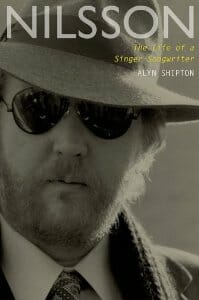Nilsson: The Life Of A Singer-Songwriter by Alyn Shipton
He put the lime in the coconut

Harry Nilsson’s story can be adjusted to fit any number of narratives. He’s the poor kid who made good but couldn’t handle success. The hard-working banker who wrote songs all night. The wacky artist. The Beatles fan who tried to drink his idols under the table. One of a crop of artists in the ‘60s and ‘70s who helped redefine the power of the studio in pop music. A symbol of the crazy excesses of the recording industry in the old days.
Alyn Shipton’s biography of Nilsson (the first) shows in meticulous detail the ways these stories come together to capture a man described both with superlatives—“finest white male singer on the planet”—and caveats— “nobody…is as much of a paradox.”
Biographies about musicians from the ‘60s and ‘70s can often be reduced to a sort of checklist:
Born? Brooklyn. Check.
Source of song? Shipton believes Nilsson suffered a “deep psychological wound” when his dad left. Mom wrote some songs, and she also liked booze and forging checks—Nilsson had to hold up a liquor store once to pay off a debtor (he did it with his hand in a pocket pretending it was a gun). So young Nilsson had music in his blood, plus an intense childhood for inspiration. Check.
Pop awakening? Listening to groups like the Coasters and Little Richard on the radio. Check.
Nilsson’s story, however, diverges from the familiar path of your rock and roller. He lands a job at a bank, not often a stomping ground for pop-smiths (though one notable poet, Wallace Stevens, spent much of his life working as an insurance man).
From this vantage point, Nilsson saw “two ways of breaking into the music business.” He could “pound the streets,” or he could get in tight with the bunch of studio musicians and songwriters responsible for the lion’s share of the pop coming out of Los Angeles. (For more information about this gang, read Kent Hartman’s The Wrecking-Crew: The Inside Story Of Rock And Roll’s Best Kept Secret.)
Nilsson first spent some time working the pavement. Then he switched gears and eventually met Phil Spector, whose girl group wall-of-sound was sweeping America around this time, and John Marascalo, who had written Little Richard’s “Rip It Up.” His songwriting rapidly improved—Nilsson’s “This Could Be The Night,” recorded by Spector with the Modern Folk Quartet, found a big admirer in the Beach Boys’ Brian Wilson, no slouch in the songwriting department himself. Nilsson now only needed the right connections.
Nilsson arrived with Pandemonium Shadow Show, in 1967. The album mixed his mom’s love of Tin Pan Alley and vaudeville, his own admiration for the Beatles and a knack for studio wizardry and big, brassy sounds that show Spector’s influence. Not imitation: Nilsson’s songs have a levity and swing completely unlike the thunderous battering of Spector’s work. “You Can’t Do That,” an homage to the Beatles, also served as a post-modern manifesto— Nilsson composed the song entirely from lines written by the Fab Four. And the Beatles famously dubbed Nilsson their favorite artist.
The albums Nilsson released between 1967 and 1972 represent his most exciting work. At the peak of his powers, with the best musicians that LA and London had to offer, and through a never-ending series of takes and retakes, dubs and overdubs, Nilsson expanded and improved his unique brand of pop pandemonium. He incorporated soul, blues, rock and doo-wop into his original mish-mash. He took his own composition, “Coconut,” an instantly memorable piece of childish nonsense—“she put the lime in the coconut, she drank ‘em both up”—and an excellent audition for ventriloquist school (Nilsson sings in a different voice for each of the songs’ three characters) to number eight on the pop charts.
-

-

-

-

-

-

-

-

-

-

-

-

-

-

-

-

-

-

-

-

-

-

-

-

-

-

-

-

-

-

-

-

-

-

-

-

-

-

-

-








































